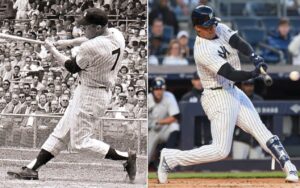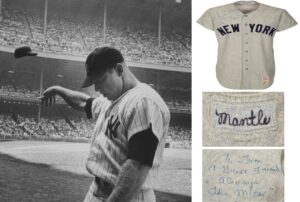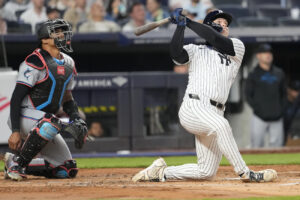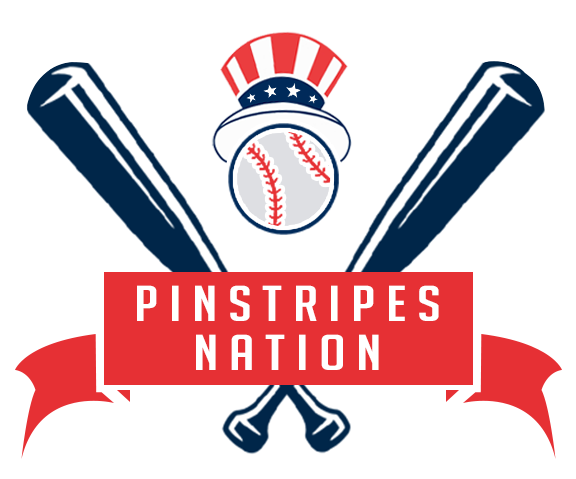Mickey Mantle: The greatest switch hitter in baseball
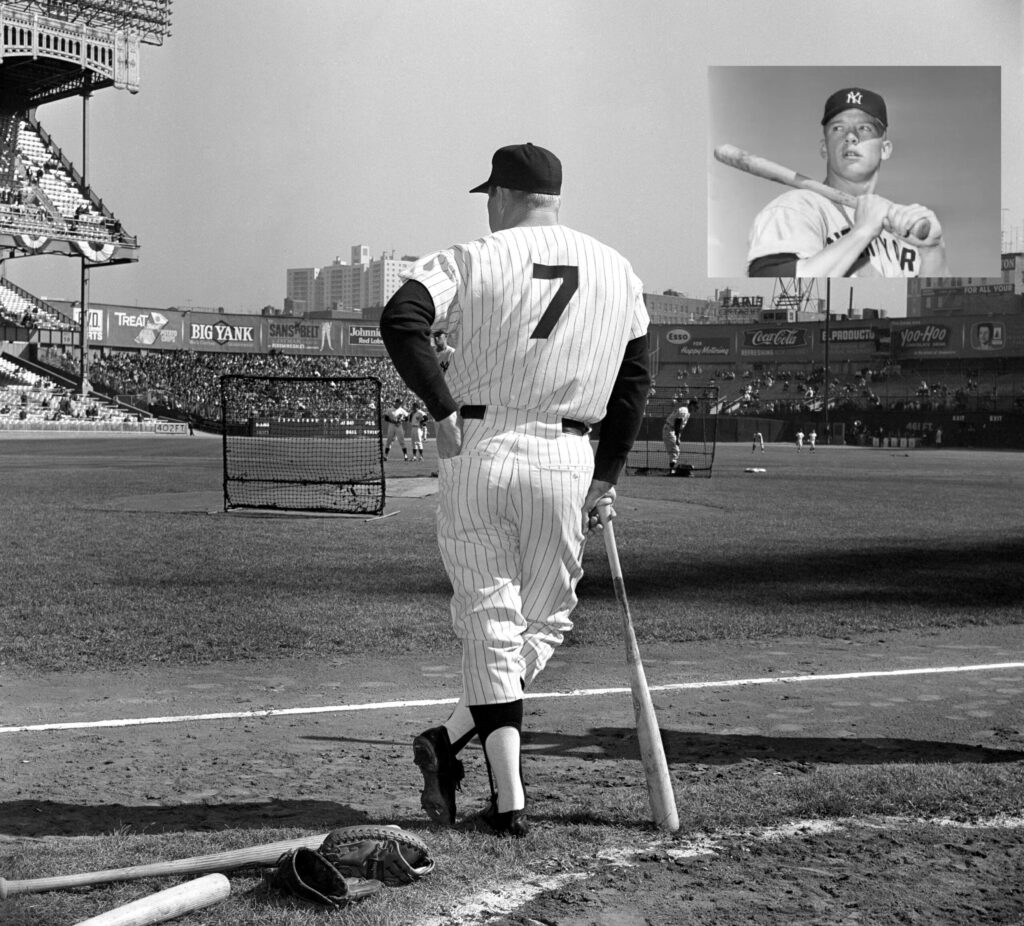
-
 John Allen
John Allen
- December 5, 2022
- 9:26 am
- No Comments
Table of Contents
| Position | Centerfielder and First Baseman |
| Active years | 1951-1968 |
| MLB Teams (years) | New York Yankees (1951–1968) |
| Debut | April 17, 1951 (Age 19 vs. Boston Red Sox) |
| Last game | September 28, 1968 (Age 36 vs. Boston Red Sox) |
| Date of Birth | October 20, 1931 |
| Native place | Spavinaw, OK |
| Batted | Both |
| Threw | Right |
| All-Star | ×20 (1952–1965, 1967, 1968) |
| World Champions | ×7 (1951–1953, 1956, 1958, 1961, 1962) |
| AL MVP | ×3 (1956, 1957, 1962) |
| Number retired | New York Yankees No. 7 |
| Hall of Fame year | 1974 (322/365 BBWAA votes) |
| MLB Awards | Triple Crown (1956) Gold Glove Award (1962) AL batting champion (1956) 4× AL home run leader (1955, 1956, 1958, 1960) AL RBI leader (1956) Monument Park honoree Major League Baseball All-Century Team |
| Legacy | Oklahoma Hall of Fame in 1964 |
| Featured on a United States postage stamp | |
| Golden Plate Award of the American Academy of Achievement | |
| Nickname | The Mick, The Commerce Comet, or Muscles |
The Bio
The Majestic Player
Mickey Mantle was one of the most famous and talented baseball players of all time. His drive and love for the game pushed him past injuries and into the record books. From 1951 to 1968, Mantle played center field, right field, and first base for the New York Yankees in Major League Baseball (MLB). Mantle was one of the best players and sluggers, and many people think he was the best switch-hitter ever. Mantle was put into the Baseball Hall of Fame in 1974, and the Major League Baseball All-Century Team was chosen for him in 1999. In 1956, Mickey Mantle led the major leagues in batting average (.353), home runs (52), and runs batted in ((130 RBI) to win the Triple Crown.
Mickey Mantle was an All-Star for 16 seasons and played in 16 of the 20 All-Star Games that were held during his career. He was named the Most Valuable Player (MVP) of the American League (AL) three times and won a Gold Glove once. Mantle played in 12 World Series, and he won seven of them. He still holds the records for the most home runs (18), RBIs (40), extra-base hits (26), runs (42), walks (43), and total bases in a World Series (123).

Mickey Mantle was one of the best offensive threats of any center fielder in baseball history. The switch-hitter continues to have “the second-highest career OPS+ among center fielders.” The first position belongs to Mike Trout. When Mantle retired, he boasted the best stolen-base percentage in MLB then. Also, compared to the other four center fielders on the All-Century team, Mickey Mantle’s career rate of grounding into double plays was the lowest, and he had the highest on-base percentage and slugging percentage in the World Series.
Mickey Mantle could hit for both average and power. His home runs gave rise to the term “tape-measure homes” when a play-by-play announcer reacted to one of Mantle’s home runs in 1953. He hit 536 home runs in his career and hit at least .300 ten times. Mickey Mantle is tied with Jim Thome for the most walk-off home runs in his career, with 13. Twelve of them came in the regular season, and one came in the playoffs. He is the only player in baseball history to hit 150 home runs from both sides of the plate.
Born to play
Even before he was born, Mickey Mantle was getting ready for his life as a major league baseball player. Father Elvin Mantle was a semi-pro player. He said that if he had a son, he would name him Mickey after the best catcher in baseball at the time, Mickey Cochrane. So, when Mutt’s wife, Lovell, gave birth to a boy in Spavinaw, Oklahoma, on October 20, 1931, they gave him the name Mickey Charles Mantle. He went on to become a famous baseball player. Mickey Mantle also liked to play football, but he got hurt early in his freshman year of high school, which almost cost him his life and put an end to his football career. During a football game, a teammate kicked him in the lower leg. In just a few hours, his ankle swelled up to three times its normal size, and he got a fever of 104 degrees. His parents took the 14-year-old to the local hospital, where doctors told them he had “osteomyelitis, a potentially fatal bone disease that had gotten worse because of the injury.” Doctors told the Mantles that the child’s life could only be saved by cutting off the leg.
The parents of Mickey Mantle went to the Crippled Children’s Hospital in Oklahoma City to get a second opinion. Doctors there agreed that he had osteomyelitis, but their treatment plan was much less extreme: eight shots a day of a new miracle drug called penicillin. Mickey’s ankle stopped hurting after a week, and he was soon back playing sports. His time playing football was over, but he was just getting started with baseball.
The chance
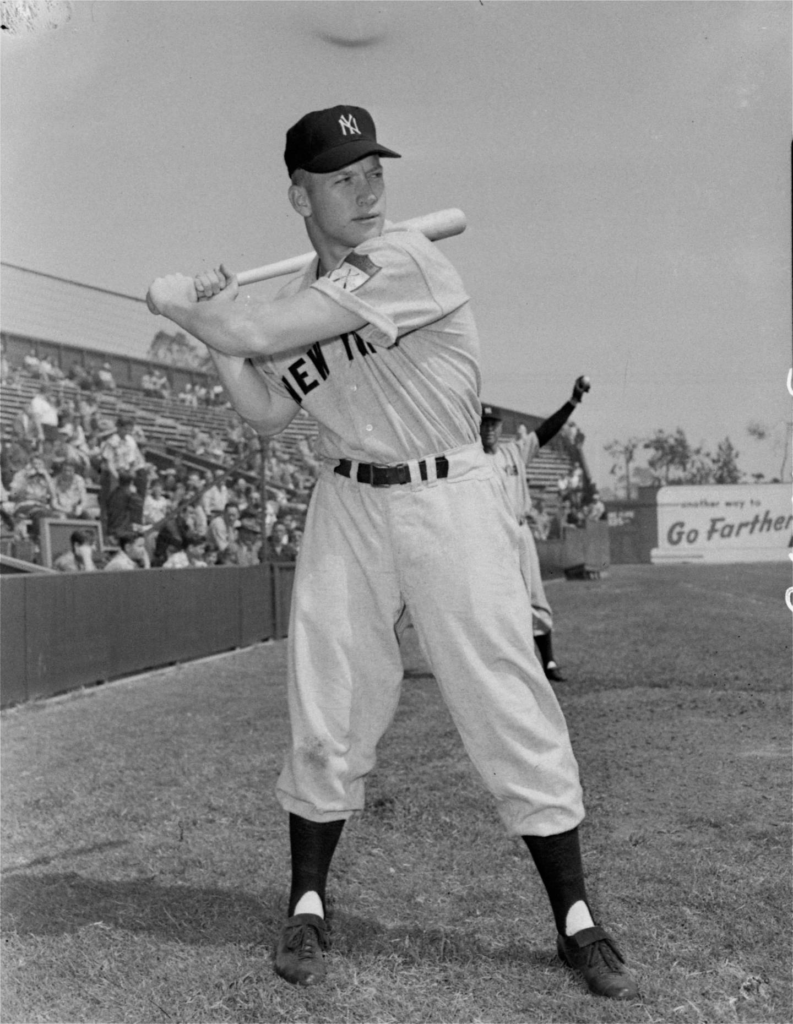
By the time Mickey Mantle was 15 and was a player for the Baxter Springs Whiz Kids. Tom Greenwade, a scout for the New York Yankees, came to Baxter Springs at the end of the 1948 season to check out Billy Johnson, the third baseman on Mantle’s team. But he quickly turned his attention to the 16-year-old shortstop who hit two long home runs, one with his right hand and the other with his left. Both went into a creek that was a long way from the outfield fence. Greenwood went up to Mantle after the game and asked, “How’d you like to play for the Yankees?” Both Mickey Mantle and his father were shocked at first, but they soon got excited about Mickey joining the Yankees. Greenwade told Mickey that since he was only 16 years old, the Yankees couldn’t sign him until he graduated from high school.
Mickey Mantle got his first taste of the big leagues on September 17, 1950, when the Yankees called him up. When Joe DiMaggio said on March 1 that 1951 would be his last season, he turned up the heat. The next day, manager Casey Stengel told the press that Mantle would succeed DiMaggio. Even though he was suddenly put under a lot of pressure, Mantle did well in spring training. During batting practice, he hit huge home runs, and during running drills, he left his teammates in the dust.
Stengel was amazed, and he saw the future of the Yankees in the 19-year-old who had never even stepped to the plate in a major-league game.
“He’s faster than any power hitter I’ve ever seen and stronger than any speedster I’ve ever seen. No one has ever had more of both speed and power at the same time. This kid isn’t making sense. He does too well. It’s very hard to understand,” the manager said.
Mickey Mantle’s first game in the major leagues was on April 17, 1951, against the Boston Red Sox at Yankee Stadium. Even though he had a good start to the season, hitting well in April and early May, he had a terrible June and early July, so Stengel sent him back to the minor leagues to get more experience. It got Mantle fired up, and for the next two months, he played really well for the Yankees’ Triple-A team in Kansas City. By the end of August, Mantle had played 40 games for Kansas City and hit .361 with 11 home runs and 60 RBIs. The Yankees then called him back. Upon his return, Mickey Mantle was assigned uniform number 7, which he would wear for the next 18 years. Mantle hit.284 with six home runs and 20 RBIs in the last 27 games of the season.
The Yankees won the American League pennant on September 28. In the World Series, they played the New York Giants, who play in the city across the street. In the fifth inning of Game Two, Willie Mays, a rookie for the Giants, hit a fly ball halfway between Mickey Mantle and Joe DiMaggio in right-center field. During the chase, Mickey tore the ligaments in his knee so badly that he had to have surgery.

Became the greatest switch hitter in baseball
In 1952, Mickey Mantle went back to the Yankees and took over for Joe DiMaggio in center field. He hit a ball. 311 and hit 23 home runs, drove in 87 runs, and scored 94 runs. He made the All-Star team for the first of 18 straight years.
The switch-hitter averaged 28 home runs, 98 RBI, and 118 runs per season from 1953 to 1955. In 1954, Mickey Mantle had 129 runs, which was the most in the American League. In 1955, he had 37 home runs, a.431 on-base percentage, and a.611 slugging percentage, which was the most in the AL. In 1956, he hit .353 and had 52 home runs and 130 RBI. Mickey Mantle also won the AL Triple Crown and the first of two AL Most Valuable Player Awards in a row. In his first eight years with the Yankees, they won seven American League pennants and five World Series.
According to the Society for American Baseball Research, “in the days before instant replay, electronic measuring tools, and landmark distances carved into outfield concourses, no player’s home runs caused more stories, controversy, myths, and legends than Mickey Mantle’s.” This began in 1948 when Tom Greenwade found him. It reached the pinnacle at Griffith Stadium where he hit his biggest home run. Mantle lifted the Senators’ Chuck Stobbs throw to a massive height on April 17, 1953.
Mickey Mantle won the Triple Crown in 1956. He led the major leagues in batting average (.353), home runs (52), and RBIs (130). He also led the league in runs scored (132) and was named the AL’s Most Valuable Player. The Yankees beat the Dodgers in seven games in the World Series. Don Larsen’s perfect game was the best part. Mantle made six runs, including three homers and four drives.
Even though he was always hurting, Mantle kept doing well over the next four seasons. In 1957, he won his second MVP award, another home run title, and two more pennants. The Yankees got Roger Maris from the Kansas City Athletics to improve their offense following their relegation to the third position. But the 296-foot right-field wall at Yankee Stadium made Maris, a left-handed pull hitter, a perfect fit for the Yankees. They were right in the end.
Mickey Mantle vs. Roger Maris

In 1960, the Yankees came back and won the pennant with Maris and Mantle in their lineup. Mickey Mantle led the league in home runs with 40 and runs scored with 119, but Maris won the most valuable player award in the closest vote ever. Mantle had a great World Series, hitting .400 with three home runs and 11 RBIs. However, the Yankees lost to the Pittsburgh Pirates when Pittsburgh second baseman Bill Mazeroski hit a dramatic walk-off home run in Game Seven.
During the famous home-run chase of 1961, Mickey Mantle was the media’s favorite to win. Most New York sportswriters thought he was the “Real Yankee,” a player who deserved to break the record. Maris was seen as an outsider who was trying to steal the crown from Babe Ruth‘s rightful heir apparent because he was often shown in the media to be grumpy and angry.
All season, Maris and Mantle were tied for most home runs. With 18 games left in the season on September 10, Maris had 56 home runs and Mantle had 53. But the expected race down the last stretch did not happen. Mickey Mantle’s muscles had been stiff and sore for weeks, and then he got a bad cold that made him tired and kept him from playing in four games from September 19 to September 22. On September 23, he went back to play in Boston, and in his first at-bat, against Don Schwall, he hit his 54th home run. But the next day, Mickey Mantle didn’t hit at all and was taken out of the game in the sixth inning because he was sick. Due to side effects from his medicine, he missed ten of the Yankees’ last 12 games. He hit 54 home runs by the end of the season.
Mickey Mantle missed 39 games in 1962, but he still won his third MVP award and led New York to its third straight pennant and second straight world title. He hit .321 and had 30 home runs, 89 RBIs, and 96 runs scored that year. He also had the highest on-base percentage (.486) and slugging percentage (.605) in the league. In seven games, the Yankees beat the San Francisco Giants to win the World Series. During that winter, the Yankees dug deep and gave Mantle a $100,000 contract. Mickey Mantle was only the fifth player in history to get a deal worth that much.
On May 22, 1963, the Yankees and Athletics were playing Kansas City at Yankee Stadium. The score was 7-7 going into the bottom of the 11th inning. Mickey Mantle hit left-handed, and a fastball from Bill Fischer hit the right-field roof just two feet from the top. He said it was the most difficult ball he had ever hit. Fans, experts, eyewitnesses, scientists, and charlatans have been arguing for years about how far the ball would have gone if it hadn’t hit the building. Estimates range from 475 feet to 734 feet, with the most likely being in the middle 500s.
Mickey Mantle did well in 1964 because he stayed healthy and hit well. He hit .303 with 35 home runs, 111 RBIs, and a .423 on-base percentage, which was the best in the league. His team had its fifth straight pennant though the St. Louis Cardinals beat them in the World Series. As of the 2011 World Series, he still held the record with 18 home runs in the World Series.
The dusk

On September 25, 1968, Mickey Mantle appeared for the final time as a player at Yankee Stadium. He ended his career with the last game three days later. On March 1, 1969, exactly 18 years after Joe DiMaggio said that 1951 would be his last year playing baseball, Mantle also said that he would no longer play. Mickey Mantle Day was held at the Stadium on June 8. Mantle’s number 7, which he wore for many years, was retired at the ceremony, which was attended by more than 70,000 fans. He joined other great players whose numbers had already been retired (Ruth, Gehrig, and DiMaggio).
Mickey Mantle quit baseball with a batting average of .298, 536 home runs, 1,676 runs scored, 1,509 RBI, 1,733 walks, and 1,509 runs batted in. An All-Star twenty times, the hitter got the Gold Glove award in 1962 and had seven World Series rings. In the Fall Classic, he played 12 times and hit a record 18 home runs.
In 1973, at the Old-Timers Game at Yankee Stadium, Mantle faced his old friend Whitey Ford. Mantle batted right-handed, and Ford batted left-handed. After fouling off a few pitches, he hit a huge home run over the 402-foot sign by the bullpen. Some people think that this is now his last home run at Yankee Stadium.
In 1974, Mantle was chosen for the Hall of Fame. Mantle was told he had hepatitis, cirrhosis of the liver, and liver cancer on January 7, 1994. On August 13, 1995, he died.
Mickey Mantle’s Greatest Moments
- 16-time AL All-Star (1952-1965, 1967 & 1968)
- 3-time AL MVP (1956, 1957 & 1962)
- AL Triple Crown (1956)
- AL Gold Glove Winner (1962)
- AL Batting Average Leader (1956)
- 3-time AL On-Base Percentage Leader (1955, 1962 & 1964)
- 4-time AL Slugging Percentage Leader (1955, 1956, 1961 & 1962)
- 6-time AL OPS Leader (1952, 1955, 1956, 1960, 1962 & 1964)
- 5-time AL Runs Scored Leader (1954, 1956-1958 & 1960)
- 3-time AL Total Bases Leader (1956, 1958 & 1960)
- AL Triples Leader (1955)
- 4-time AL Home Runs Leader (1955, 1956, 1958 & 1960)
- AL RBI Leader (1956)
- 5-time AL Bases on Balls Leader (1955, 1957, 1958, 1961 & 1962)
- 20-Home Run Seasons: 14 (1952-1962, 1964, 1966 & 1967)
- 30-Home Run Seasons: 9 (1955-1962 & 1964)
- 40-Home Run Seasons: 4 (1956, 1958, 1960 & 1961)
- 50-Home Run Seasons: 2 (1956 & 1961)
- 100 RBI Seasons: 4 (1954, 1956, 1961 & 1964)
- 100 Runs Scored Seasons: 9 (1953-1961)
- Won seven World Series with the New York Yankees (1951, 1952, 1953, 1956, 1958, 1961 & 1962)
- Baseball Hall of Fame: Class of 1974
FAQs about Mickey Mantle
How tall was Mickey Mantle?
1.82 m
What position did Mickey Mantle play?
First baseman, Center fielder
How many times was Mickey Mantle an All-Star?
He was named to 20 All-Star Games.
What number has Mickey Mantle’s shirt?
7
How much is a Mickey Mantle baseball card?
$12.6 million
How much is a Mickey Mantle rookie card?
Mickey Mantle’s rookie card sells for a record-breaking $12.6 million.
When did Mickey Mantle die?
August 13, 1995
Why are Mickey Mantle cards so expensive?
Mantle card is very rare, as the Topps printed cards No. 311-407 in small numbers only in 1952.
What year was Mickey Mantle a rookie?
1951
How many 1952 Mickey Mantle cards exist?
About 1,800 Mickey Mantle rookie cards do exist.
How old was Mickey Mantle when he died?
63 years
How much did Mickey Mantle drink?
Mickey Mantle once said: “If I had a drink to start the day, I’d go out for lunch and go through three or four bottles of wine in the course of the afternoon,”
How did Mickey Mantle die?
Liver cancer
When did Mickey Mantle retire?
March 1, 1969
Which Mickey Mantle cards are worth the money?
The Holy Grail: 1952 Topps Mickey Mantle.
1951 Bowman Mickey Mantle – The Rookie Card!
1952 Berk Ross Mickey Mantle.
1952 Bowman Mickey Mantle #101.
1953 Bowman Mickey Mantle #59.
1953 Topps Mickey Mantle #82.
1956 Topps Mickey Mantle #135.
1991 Score Mantle Auto.
How much is a Mickey Mantle-signed baseball worth?
The average value of a “Mickey Mantle autographed ball” is $476.47. Sold between $25.00 and $1,500.00.
How much is a Mickey Mantle-signed baseball worth?
The average value of a “Mickey Mantle autographed ball” is $476.47. Sold between $25.00 and $1,500.00.
How much is Mickey Mantle’s signature worth?
A Mickey Mantle’s signed photo fetches about $150. -$300.
Where is Mickey Mantle buried?
Sparkman-Hillcrest Memorial Park Cemetery
Why is Mickey Mantle so famous?
Mickey Mantle is famous for his remarkable power and speed in hitting.
How many home runs did Mickey Mantle hit in 1961?
54 home runs
Where did Mickey Mantle go to school?
The University of Oklahoma
How many world series did Mickey Mantle win?
7
How many hits did Mickey Mantle have?
2,415 hits
The Stats
| SUMMARY | WAR | AB | H | HR | BA | R | RBI | SB | OBP | SLG | OPS | OPS+ |
| Career | 110.2 | 8102 | 2415 | 536 | .298 | 1676 | 1509 | 153 | .421 | .557 | .977 | 172 |
Mickey Mantle’s Standard Batting Record
| Year | G | PA | AB | R | H | 2B | 3B | HR | RBI | SB | CS | BB | SO | BA | OBP | SLG | OPS | OPS+ | TB | GDP | HBP | SH | SF | IBB | Pos |
| 1951 | 96 | 386 | 341 | 61 | 91 | 11 | 5 | 13 | 65 | 8 | 7 | 43 | 74 | .267 | .349 | .443 | .792 | 117 | 151 | 3 | 0 | 2 | 2 | 9H/8 | |
| 1952 | 142 | 626 | 549 | 94 | 171 | 37 | 7 | 23 | 87 | 4 | 1 | 75 | 111 | .311 | .394 | .530 | .924 | 162 | 291 | 5 | 0 | 2 | 10 | *89/5H | |
| 1953 | 127 | 540 | 461 | 105 | 136 | 24 | 3 | 21 | 92 | 8 | 4 | 79 | 90 | .295 | .398 | .497 | .895 | 145 | 229 | 2 | 0 | 0 | 3 | *8/H976 | |
| 1954 | 146 | 651 | 543 | 129 | 163 | 17 | 12 | 27 | 102 | 5 | 2 | 102 | 107 | .300 | .408 | .525 | .933 | 158 | 285 | 3 | 0 | 2 | 4 | 7 | *8/6H49 |
| 1955 | 147 | 638 | 517 | 121 | 158 | 25 | 11 | 37 | 99 | 8 | 1 | 113 | 97 | .306 | .431 | .611 | 1.042 | 180 | 316 | 4 | 3 | 2 | 3 | 6 | *8/H6 |
| 1956 | 150 | 652 | 533 | 132 | 188 | 22 | 5 | 52 | 130 | 10 | 1 | 112 | 99 | .353 | .464 | .705 | 1.169 | 210 | 376 | 4 | 2 | 1 | 4 | 6 | *8/H |
| 1957 | 144 | 623 | 474 | 121 | 173 | 28 | 6 | 34 | 94 | 16 | 3 | 146 | 75 | .365 | .512 | .665 | 1.177 | 221 | 315 | 5 | 0 | 0 | 3 | 23 | *8/H |
| 1958 | 150 | 654 | 519 | 127 | 158 | 21 | 1 | 42 | 97 | 18 | 3 | 129 | 120 | .304 | .443 | .592 | 1.035 | 188 | 307 | 11 | 2 | 2 | 2 | 13 | *8 |
| 1959 | 144 | 640 | 541 | 104 | 154 | 23 | 4 | 31 | 75 | 21 | 3 | 93 | 126 | .285 | .390 | .514 | .904 | 151 | 278 | 7 | 2 | 1 | 2 | 6 | *8/H |
| 1960 | 153 | 644 | 527 | 119 | 145 | 17 | 6 | 40 | 94 | 14 | 3 | 111 | 125 | .275 | .399 | .558 | .957 | 162 | 294 | 11 | 1 | 0 | 5 | 6 | *8/H |
| 1961 | 153 | 646 | 514 | 131 | 163 | 16 | 6 | 54 | 128 | 12 | 1 | 126 | 112 | .317 | .448 | .687 | 1.135 | 206 | 353 | 2 | 0 | 1 | 5 | 9 | *8/H |
| 1962 | 123 | 502 | 377 | 96 | 121 | 15 | 1 | 30 | 89 | 9 | 0 | 122 | 78 | .321 | .486 | .605 | 1.091 | 195 | 228 | 4 | 1 | 0 | 2 | 9 | *89/H |
| 1963 | 65 | 213 | 172 | 40 | 54 | 8 | 0 | 15 | 35 | 2 | 1 | 40 | 32 | .314 | .441 | .622 | 1.063 | 196 | 107 | 5 | 0 | 0 | 1 | 4 | 8H |
| 1964 | 143 | 567 | 465 | 92 | 141 | 25 | 2 | 35 | 111 | 6 | 3 | 99 | 102 | .303 | .423 | .591 | 1.015 | 177 | 275 | 9 | 0 | 0 | 3 | 18 | *879H |
| 1965 | 122 | 435 | 361 | 44 | 92 | 12 | 1 | 19 | 46 | 4 | 1 | 73 | 76 | .255 | .379 | .452 | .831 | 137 | 163 | 11 | 0 | 0 | 1 | 7 | 7H |
| 1966 | 108 | 393 | 333 | 40 | 96 | 12 | 1 | 23 | 56 | 1 | 1 | 57 | 76 | .288 | .389 | .538 | .927 | 170 | 179 | 9 | 0 | 0 | 3 | 5 | 8H/7 |
| 1967 | 144 | 553 | 440 | 63 | 108 | 17 | 0 | 22 | 55 | 1 | 1 | 107 | 113 | .245 | .391 | .434 | .825 | 150 | 191 | 9 | 1 | 0 | 5 | 7 | *3H |
| 1968 | 144 | 547 | 435 | 57 | 103 | 14 | 1 | 18 | 54 | 6 | 2 | 106 | 97 | .237 | .385 | .398 | .782 | 143 | 173 | 9 | 1 | 1 | 4 | 7 | *3H |
| 18 Yrs | 2401 | 9910 | 8102 | 1676 | 2415 | 344 | 72 | 536 | 1509 | 153 | 38 | 1733 | 1710 | .298 | .421 | .557 | .977 | 172 | 4511 | 113 | 13 | 14 | 47 | 148 | |
| 162 Game Avg. | 162 | 669 | 547 | 113 | 163 | 23 | 5 | 36 | 102 | 10 | 3 | 117 | 115 | .298 | .421 | .557 | .977 | 172 | 304 | 8 | 1 | 1 | 10 | ||
| G | PA | AB | R | H | 2B | 3B | HR | RBI | SB | CS | BB | SO | BA | OBP | SLG | OPS | OPS+ | TB | GDP | HBP | SH | SF | IBB | Pos |
Mickey Mantle’s Postseason Batting Record
| Year | G | PA | AB | R | H | 2B | 3B | HR | RBI | SB | CS | BB | SO | BA | OBP | SLG | OPS | TB | GDP | HBP | SH | SF | IBB | WPA | cWPA |
| 1951 | 2 | 7 | 5 | 1 | 1 | 0 | 0 | 0 | 0 | 0 | 0 | 2 | 1 | .200 | .429 | .200 | .629 | 1 | 0 | 0 | 0 | 0 | 0.08 | 2.5% | |
| 1952 | 7 | 32 | 29 | 5 | 10 | 1 | 1 | 2 | 3 | 0 | 0 | 3 | 4 | .345 | .406 | .655 | 1.061 | 19 | 0 | 0 | 0 | 0 | 0.33 | 29.0% | |
| 1953 | 6 | 27 | 24 | 3 | 5 | 0 | 0 | 2 | 7 | 0 | 1 | 3 | 8 | .208 | .296 | .458 | .755 | 11 | 0 | 0 | 0 | 1 | 0.26 | 14.3% | |
| 1955 | 3 | 10 | 10 | 1 | 2 | 0 | 0 | 1 | 1 | 0 | 0 | 0 | 2 | .200 | .200 | .500 | .700 | 5 | 1 | 0 | 0 | 0 | 0 | -0.10 | -6.1% |
| 1956 | 7 | 30 | 24 | 6 | 6 | 1 | 0 | 3 | 4 | 1 | 0 | 6 | 5 | .250 | .400 | .667 | 1.067 | 16 | 1 | 0 | 0 | 0 | 1 | 0.13 | 2.0% |
| 1957 | 6 | 22 | 19 | 3 | 5 | 0 | 0 | 1 | 2 | 0 | 2 | 3 | 1 | .263 | .364 | .421 | .785 | 8 | 0 | 0 | 0 | 0 | 0 | -0.05 | -4.0% |
| 1958 | 7 | 31 | 24 | 4 | 6 | 0 | 1 | 2 | 3 | 0 | 0 | 7 | 4 | .250 | .419 | .583 | 1.003 | 14 | 0 | 0 | 0 | 0 | 1 | 0.07 | -5.2% |
| 1960 | 7 | 33 | 25 | 8 | 10 | 1 | 0 | 3 | 11 | 0 | 1 | 8 | 9 | .400 | .545 | .800 | 1.345 | 20 | 0 | 0 | 0 | 0 | 2 | 0.52 | 36.7% |
| 1961 | 2 | 6 | 6 | 0 | 1 | 0 | 0 | 0 | 0 | 0 | 0 | 0 | 2 | .167 | .167 | .167 | .333 | 1 | 0 | 0 | 0 | 0 | 0 | -0.04 | -0.9% |
| 1962 | 7 | 29 | 25 | 2 | 3 | 1 | 0 | 0 | 0 | 2 | 0 | 4 | 5 | .120 | .241 | .160 | .401 | 4 | 0 | 0 | 0 | 0 | 0 | -0.04 | -2.0% |
| 1963 | 4 | 16 | 15 | 1 | 2 | 0 | 0 | 1 | 1 | 0 | 0 | 1 | 5 | .133 | .188 | .333 | .521 | 5 | 0 | 0 | 0 | 0 | 0 | -0.12 | -5.1% |
| 1964 | 7 | 30 | 24 | 8 | 8 | 2 | 0 | 3 | 8 | 0 | 0 | 6 | 8 | .333 | .467 | .792 | 1.258 | 19 | 0 | 0 | 0 | 0 | 1 | 0.53 | 22.4% |
| 12 Yrs (12 Series) | 65 | 273 | 230 | 42 | 59 | 6 | 2 | 18 | 40 | 3 | 4 | 43 | 54 | .257 | .374 | .535 | .908 | 123 | 2 | 0 | 0 | 0 | 6 | 1.56 | 83.5% |
| 12 WS | 65 | 273 | 230 | 42 | 59 | 6 | 2 | 18 | 40 | 3 | 4 | 43 | 54 | .257 | .374 | .535 | .908 | 123 | 2 | 0 | 0 | 0 | 6 | 1.56 | 83.5% |
Mickey Mantle’s Career Graph
| Hall of Fame | All-Star Games | Awards | MVP (rank, share) |
| 1974 BBWAA (88.2%) Selected to HOF in 1974 by BBWAA | 1952 1953 (CF) 1954 (CF) 1955 (CF) 1956 (CF) 1957 (CF) 1958 (CF) 1959-1 * 1959-2 (CF) 1960-1 (CF) 1960-2 (CF) 1961-1 (CF) 1961-2 (CF) 1962-1 (RF) 1962-2 1963 1964 (CF) 1965 1967 * 1968 * | 1952 AP All-Star 1952 TSN All-Star 1956 AP All-Star 1956 TSN All-Star 1956 AL Triple Crown 1956 AL MVP 1956 Major League Player of the Year 1956 AL Batting Title 1957 AL MVP 1957 AP All-Star 1957 TSN All-Star 1958 AP All-Star 1961 AP All-Star 1961 TSN All-Star 1962 AL MVP 1962 AL TSN All-Star 1964 AP All-Star 1964 AL TSN All-Star 1965 Hutch Award | 1952 AL (3, 43%) 1953 AL (22, 1%) 1954 AL (15, 5%) 1955 AL (5, 34%) 1956 AL (1, 100%) 1957 AL (1, 69%) 1958 AL (5, 38%) 1959 AL (17, 4%) 1960 AL (2, 66%) 1961 AL (2, 71%) 1962 AL (1, 84%) 1964 AL (2, 61%) 1965 AL (25, 1%) 1966 AL (19, 2%) 3 MVPs 5.79 Career Shares (7th) |
| Gold Gloves | Wins Above Replacement | WAR Position Players | Offensive WAR |
| 1962 AL (OF) | 1952 AL 6.4 (4th) 1953 AL 5.8 (4th) 1954 AL 6.9 (4th) 1955 AL 9.5 (1st) 1956 AL 11.2 (1st) 1957 AL 11.3 (1st) 1958 AL 8.7 (1st) 1959 AL 6.6 (3rd) 1960 AL 6.4 (3rd) 1961 AL 10.4 (1st) 1962 AL 6.0 (4th) Career 110.2 (21st) | 1952 AL 6.4 (2nd) 1953 AL 5.8 (3rd) 1954 AL 6.9 (4th) 1955 AL 9.5 (1st) 1956 AL 11.2 (1st) 1957 AL 11.3 (1st) 1958 AL 8.7 (1st) 1959 AL 6.6 (1st) 1960 AL 6.4 (2nd) 1961 AL 10.4 (1st) 1962 AL 6.0 (2nd) Career 110.2 (16th) | 1952 AL 6.3 (2nd) 1953 AL 5.3 (3rd) 1954 AL 7.1 (2nd) 1955 AL 8.4 (1st) 1956 AL 10.6 (1st) 1957 AL 11.3 (1st) 1958 AL 9.3 (1st) 1959 AL 6.3 (1st) 1960 AL 6.7 (1st) 1961 AL 10.6 (1st) 1962 AL 7.6 (1st) 1964 AL 6.7 (1st) 1966 AL 4.7 (7th) 1967 AL 4.6 (9th) Career 116.3 (12th) |
| Defensive WAR | Batting Average | On-Base% | Slugging % |
| 1955 AL 1.1 (7th) | 1952 AL .311 (3rd) 1955 AL .306 (7th) 1956 AL .353 (1st) 1957 AL .365 (2nd) 1958 AL .304 (7th) 1961 AL .317 (4th) 1962 AL .321 (2nd) 1964 AL .303 (4th) Career .298 (240th) | 1952 AL .394 (4th) 1953 AL .398 (7th) 1954 AL .408 (3rd) 1955 AL .431 (1st) 1956 AL .464 (2nd) 1957 AL .512 (2nd) 1958 AL .443 (2nd) 1959 AL .390 (6th) 1960 AL .399 (4th) 1961 AL .448 (2nd) 1962 AL .486 (1st) 1964 AL .423 (1st) 1967 AL .391 (5th) 1968 AL .385 (3rd) Career .421 (19th) | 1952 AL .530 (2nd) 1953 AL .497 (6th) 1954 AL .525 (3rd) 1955 AL .611 (1st) 1956 AL .705 (1st) 1957 AL .665 (2nd) 1958 AL .592 (3rd) 1959 AL .514 (3rd) 1960 AL .558 (2nd) 1961 AL .687 (1st) 1962 AL .605 (1st) 1964 AL .591 (2nd) Career .557 (21st) |
| On-Base Plus Slugging | Games Played | Plate Appearances | Runs Scored |
| 1952 AL .924 (1st) 1953 AL .895 (5th) 1954 AL .933 (3rd) 1955 AL 1.042 (1st) 1956 AL 1.169 (1st) 1957 AL 1.177 (2nd) 1958 AL 1.035 (2nd) 1959 AL .904 (2nd) 1960 AL .957 (1st) 1961 AL 1.135 (2nd) 1962 AL 1.091 (1st) 1964 AL 1.015 (1st) 1967 AL .825 (10th) 1968 AL .782 (9th) Career .977 (14th) | 1956 AL 150 (10th) 1958 AL 150 (7th) 1960 AL 153 (2nd) Career 2,401 (89th) | 1955 AL 638 (10th) 1956 AL 652 (9th) 1958 AL 654 (6th) 1959 AL 640 (10th) 1960 AL 644 (7th) Career 9,910 (91st) | 1952 AL 94 (6th) 1953 AL 105 (3rd) 1954 AL 129 (1st) 1955 AL 121 (2nd) 1956 AL 132 (1st) 1957 AL 121 (1st) 1958 AL 127 (1st) 1959 AL 104 (2nd) 1960 AL 119 (1st) 1961 AL 131 (2nd) 1962 AL 96 (7th) 1964 AL 92 (7th) Career 1,676 (30th) |
| Hits | Total Bases | Doubles | Triples |
| 1952 AL 171 (5th) 1954 AL 163 (8th) 1955 AL 158 (9th) 1956 AL 188 (4th) 1957 AL 173 (4th) 1958 AL 158 (10th) 1959 AL 154 (9th) Career 2,415 (123rd) | 1952 AL 291 (2nd) 1954 AL 285 (3rd) 1955 AL 316 (2nd) 1956 AL 376 (1st) 1957 AL 315 (2nd) 1958 AL 307 (1st) 1959 AL 278 (4th) 1960 AL 294 (1st) 1961 AL 353 (3rd) 1964 AL 275 (8th) Career 4,511 (49th) | 1952 AL 37 (2nd) 1957 AL 28 (7th) | 1954 AL 12 (4th) 1955 AL 11 (1st) 1957 AL 6 (6th) 1960 AL 6 (8th) |
| Home Runs | Runs Batted In | Bases on Balls | Strikeouts |
| 1952 AL 23 (7th) 1953 AL 21 (7th) 1954 AL 27 (3rd) 1955 AL 37 (1st) 1956 AL 52 (1st) 1957 AL 34 (3rd) 1958 AL 42 (1st) 1959 AL 31 (4th) 1960 AL 40 (1st) 1961 AL 54 (2nd) 1962 AL 30 (7th) 1964 AL 35 (3rd) 1967 AL 22 (8th) Career 536 (18th) | 1952 AL 87 (8th) 1953 AL 92 (10th) 1954 AL 102 (5th) 1955 AL 99 (6th) 1956 AL 130 (1st) 1957 AL 94 (6th) 1958 AL 97 (5th) 1960 AL 94 (6th) 1961 AL 128 (5th) 1964 AL 111 (3rd) Career 1,509 (56th) | 1952 AL 75 (7th) 1953 AL 79 (7th) 1954 AL 102 (3rd) 1955 AL 113 (1st) 1956 AL 112 (2nd) 1957 AL 146 (1st) 1958 AL 129 (1st) 1959 AL 93 (3rd) 1960 AL 111 (2nd) 1961 AL 126 (1st) 1962 AL 122 (1st) 1964 AL 99 (2nd) 1965 AL 73 (6th) 1967 AL 107 (2nd) 1968 AL 106 (2nd) Career 1,733 (8th) | 1951 AL 74 (3rd) 1952 AL 111 (1st) 1953 AL 90 (2nd) 1954 AL 107 (1st) 1955 AL 97 (3rd) 1956 AL 99 (3rd) 1958 AL 120 (1st) 1959 AL 126 (1st) 1960 AL 125 (1st) 1961 AL 112 (3rd) 1967 AL 113 (7th) Career 1,710 (37th) |
| Stolen Bases | Adjusted OPS+ | Runs Created | Adj. Batting Runs |
| 1953 AL 8 (8th) 1955 AL 8 (8th) 1956 AL 10 (7th) 1957 AL 16 (4th) 1958 AL 18 (4th) 1959 AL 21 (2nd) 1960 AL 14 (7th) | 1952 AL 162 (2nd) 1953 AL 145 (5th) 1954 AL 158 (2nd) 1955 AL 180 (1st) 1956 AL 210 (1st) 1957 AL 221 (2nd) 1958 AL 188 (1st) 1959 AL 151 (1st) 1960 AL 162 (1st) 1961 AL 206 (1st) 1962 AL 195 (1st) 1964 AL 177 (1st) 1967 AL 150 (7th) 1968 AL 143 (8th) Career 172 (10th) | 1952 AL 115 (1st) 1953 AL 91 (10th) 1954 AL 126 (2nd) 1955 AL 148 (1st) 1956 AL 188 (1st) 1957 AL 178 (1st) 1958 AL 147 (1st) 1959 AL 117 (1st) 1960 AL 125 (1st) 1961 AL 174 (2nd) 1962 AL 126 (2nd) 1964 AL 121 (3rd) Career 2,047 (18th) | 1952 AL 46 (1st) 1953 AL 31 (5th) 1954 AL 45 (2nd) 1955 AL 61 (1st) 1956 AL 87 (1st) 1957 AL 92 (1st) 1958 AL 69 (1st) 1959 AL 40 (1st) 1960 AL 48 (1st) 1961 AL 81 (2nd) 1962 AL 60 (1st) 1963 AL 24 (10th) 1964 AL 53 (1st) 1966 AL 32 (5th) 1967 AL 34 (6th) 1968 AL 29 (7th) Career 860 (9th) |
| Adj. Batting Wins | Extra Base Hits | Times On Base | Offensive Win % |
| 1952 AL 4.7 (1st) 1953 AL 3.1 (5th) 1954 AL 4.5 (2nd) 1955 AL 5.9 (1st) 1956 AL 8.1 (1st) 1957 AL 9.0 (1st) 1958 AL 6.9 (1st) 1959 AL 4.0 (1st) 1960 AL 4.8 (1st) 1961 AL 7.7 (2nd) 1962 AL 5.8 (1st) 1963 AL 2.5 (10th) 1964 AL 5.4 (1st) 1966 AL 3.3 (5th) 1967 AL 3.6 (6th) 1968 AL 3.3 (7th) Career 85.2 (10th) | 1952 AL 67 (1st) 1954 AL 56 (4th) 1955 AL 73 (1st) 1956 AL 79 (1st) 1957 AL 68 (2nd) 1958 AL 64 (4th) 1959 AL 58 (4th) 1960 AL 63 (2nd) 1961 AL 76 (3rd) 1964 AL 62 (6th) Career 952 (53rd) | 1952 AL 246 (7th) 1954 AL 265 (4th) 1955 AL 274 (4th) 1956 AL 302 (1st) 1957 AL 319 (1st) 1958 AL 289 (1st) 1959 AL 249 (4th) 1960 AL 257 (2nd) 1961 AL 289 (2nd) 1964 AL 240 (8th) Career 4,161 (37th) | 1952 AL .770 (1st) 1953 AL .715 (3rd) 1954 AL .777 (2nd) 1955 AL .826 (1st) 1956 AL .879 (1st) 1957 AL .909 (2nd) 1958 AL .834 (1st) 1959 AL .743 (4th) 1960 AL .759 (1st) 1961 AL .866 (2nd) 1962 AL .871 (1st) 1964 AL .817 (1st) 1967 AL .727 (6th) 1968 AL .710 (9th) Career .804 (9th) |
| Intentional Bases on Balls | Caught Stealing | SB % | Power-Speed # |
| 1952 AL 10 (5th) 1954 AL 7 (10th) 1955 AL 6 (10th) 1957 AL 23 (2nd) 1958 AL 13 (1st) 1959 AL 6 (7th) 1960 AL 6 (8th) 1961 AL 9 (4th) 1962 AL 9 (6th) 1964 AL 18 (1st) Career 148 (57th) | 1951 AL 7 (7th) | 1957 AL 84.21 (2nd) 1958 AL 85.71 (2nd) 1959 AL 87.50 (1st) 1960 AL 82.35 (3rd) Career 80.11 (66th) | 1951 AL 9.9 (6th) 1953 AL 11.6 (5th) 1954 AL 8.4 (9th) 1955 AL 13.2 (4th) 1956 AL 16.8 (1st) 1957 AL 21.8 (1st) 1958 AL 25.2 (1st) 1959 AL 25.0 (1st) 1960 AL 20.7 (1st) 1961 AL 19.6 (2nd) 1962 AL 13.8 (6th) Career 238.0 (63rd) |
| AB per HR | Base-Out Runs Added (RE24) | Win Probability Added (WPA) | Situ. Wins Added (WPA/LI) |
| 1952 AL 23.9 (10th) 1953 AL 22.0 (6th) 1954 AL 20.1 (4th) 1955 AL 14.0 (2nd) 1956 AL 10.3 (1st) 1957 AL 13.9 (3rd) 1958 AL 12.4 (2nd) 1959 AL 17.5 (5th) 1960 AL 13.2 (2nd) 1961 AL 9.5 (1st) 1962 AL 12.6 (2nd) 1964 AL 13.3 (3rd) 1967 AL 20.0 (7th) 1968 AL 24.2 (9th) Career 15.1 (18th) | 1951 AL 26.72 (8th) 1952 AL 44.77 (2nd) 1953 AL 47.55 (4th) 1954 AL 57.91 (3rd) 1955 AL 67.41 (1st) 1956 AL 99.65 (1st) 1957 AL 93.45 (1st) 1958 AL 67.85 (1st) 1959 AL 40.97 (5th) 1960 AL 56.18 (1st) 1961 AL 95.52 (1st) 1962 AL 79.17 (1st) 1964 AL 65.39 (1st) 1966 AL 31.65 (9th) 1967 AL 36.18 (5th) 1968 AL 33.67 (8th) Career 977.63 (7th) | 1952 AL 4.0 (3rd) 1953 AL 3.9 (7th) 1954 AL 5.5 (4th) 1955 AL 6.3 (2nd) 1956 AL 8.4 (1st) 1957 AL 9.3 (1st) 1958 AL 6.3 (3rd) 1959 AL 3.1 (10th) 1960 AL 6.0 (1st) 1961 AL 9.0 (1st) 1962 AL 8.0 (1st) 1963 AL 3.0 (8th) 1964 AL 6.5 (1st) 1967 AL 3.9 (5th) 1968 AL 4.4 (4th) Career 94.2 (6th) | 1952 AL 3.9 (2nd) 1953 AL 3.7 (5th) 1954 AL 5.3 (2nd) 1955 AL 7.5 (1st) 1956 AL 9.4 (1st) 1957 AL 9.9 (1st) 1958 AL 8.0 (1st) 1959 AL 3.7 (7th) 1960 AL 5.2 (1st) 1961 AL 8.8 (1st) 1962 AL 7.1 (1st) 1964 AL 6.2 (1st) 1966 AL 3.6 (6th) 1967 AL 4.3 (5th) 1968 AL 3.3 (8th) Career 95.5 (6th) |
| Championship WPA (cWPA) | Base-Out Wins Added (REW) | Putouts | Def. Games as 1B |
| 1951 AL 10.4 (2nd) 1952 AL 19.0 (2nd) 1953 AL 10.9 (1st) 1954 AL 16.9 (2nd) 1955 AL 22.1 (1st) 1956 AL 19.2 (1st) 1957 AL 25.2 (1st) 1958 AL 8.9 (1st) 1960 AL 22.4 (1st) 1961 AL 24.0 (1st) 1962 AL 22.4 (1st) 1963 AL 5.9 (3rd) 1964 AL 16.9 (3rd) Career 232.4 (2nd) | 1951 AL 2.7 (8th) 1952 AL 4.7 (3rd) 1953 AL 4.8 (4th) 1954 AL 5.8 (3rd) 1955 AL 6.5 (1st) 1956 AL 9.4 (1st) 1957 AL 9.2 (1st) 1958 AL 6.9 (1st) 1959 AL 4.2 (4th) 1960 AL 5.6 (1st) 1961 AL 9.3 (1st) 1962 AL 7.7 (1st) 1964 AL 6.5 (1st) 1966 AL 3.4 (9th) 1967 AL 4.0 (5th) 1968 AL 3.8 (7th) Career 97.9 (6th) | 1968 AL 1,195 (3rd) | 1967 AL 131 (5th) 1968 AL 131 (3rd) |
| Putouts as 1B | Assists as 1B | Errors Committed as 1B | Double Plays Turned as 1B |
| 1968 AL 1,195 (3rd) | 1967 AL 91 (4th) 1968 AL 76 (4th) | 1968 AL 15 (2nd) | 1968 AL 91 (3rd) |
| Errors Committed as LF (s.1901) | Def. Games as CF (s.1901) | Putouts as CF (s.1901) | Assists as CF (s.1901) |
| 1965 AL 6 (3rd) | 1954 AL 143 (4th) 1955 AL 145 (4th) 1956 AL 144 (2nd) 1957 AL 139 (2nd) 1958 AL 150 (1st) 1959 AL 142 (2nd) 1960 AL 150 (1st) 1961 AL 150 (2nd) Career 1,742 (18th) | 1954 AL 327 (5th) 1955 AL 371 (4th) 1956 AL 367 (3rd) 1957 AL 326 (3rd) 1958 AL 329 (3rd) 1959 AL 369 (2nd) 1960 AL 324 (5th) 1961 AL 348 (3rd) Career 4,016 (28th) | 1952 AL 14 (1st) 1954 AL 20 (1st) 1955 AL 11 (2nd) 1956 AL 10 (2nd) 1957 AL 6 (5th) 1959 AL 7 (5th) 1960 AL 8 (3rd) 1961 AL 6 (5th) Career 104 (40th) |
| Errors Committed as CF (s.1901) | Double Plays Turned as CF (s.1901) | Errors Committed as RF (s.1901) | Double Plays Turned as RF (s.1901) |
| 1952 AL 10 (1st) 1953 AL 6 (3rd) 1954 AL 9 (1st) 1956 AL 4 (4th) 1957 AL 7 (1st) 1958 AL 8 (1st) 1961 AL 6 (2nd) 1962 AL 4 (4th) 1964 AL 5 (4th) Career 67 (43rd) | 1952 AL 4 (1st) 1953 AL 2 (5th) 1954 AL 5 (3rd) 1955 AL 2 (2nd) 1956 AL 3 (1st) 1957 AL 1 (5th) 1958 AL 2 (1st) 1959 AL 3 (2nd) 1960 AL 1 (3rd) 1962 AL 1 (4th) Career 25 (43rd) | 1951 AL 6 (1st) | 1951 AL 1 (4th) |
| Def. Games as OF | Putouts as OF | Assists as OF | Errors Committed as OF |
| 1952 AL 141 (5th) 1957 AL 139 (5th) 1958 AL 150 (2nd) 1960 AL 150 (2nd) 1961 AL 150 (5th) Career 2,019 (55th) | 1952 AL 347 (5th) 1955 AL 372 (4th) 1956 AL 370 (3rd) 1957 AL 324 (3rd) 1958 AL 331 (3rd) 1959 AL 366 (2nd) 1960 AL 326 (5th) 1961 AL 351 (5th) Career 4,438 (49th) | 1952 AL 15 (3rd) 1954 AL 20 (1st) | 1952 AL 12 (1st) 1954 AL 9 (2nd) 1957 AL 7 (4th) 1958 AL 8 (2nd) |
| Double Plays Turned as OF | Range Factor/9Inn as 1B | Range Factor/Game as 1B | Fielding % as 1B |
| 1952 AL 5 (1st) 1954 AL 5 (3rd) 1956 AL 3 (4th) 1959 AL 3 (5th) | 1967 AL 9.98 (3rd) 1968 AL 10.52 (2nd) | 1967 AL 9.01 (4th) 1968 AL 9.70 (2nd) | 1967 AL .993 (3rd) |
| Range Factor/9Inn as LF (s.1948) | Range Factor/Game as LF (s.1901) | Total Zone Runs as CF (s.1953) | Range Factor/9Inn as CF (s.1948) |
| 1965 AL 1.83 (5th) | 1965 AL 1.53 (5th) | 1953 AL 6 (3rd) 1955 AL 10 (2nd) 1956 AL 5 (3rd) 1959 AL 4 (4th) | 1952 AL 2.75 (5th) |
| Range Factor/Game as CF (s.1901) | Fielding % as CF (s.1901) | Total Zone Runs as OF (s.1953) | Range Factor/9Inn as OF |
| 1952 AL 2.70 (5th) 1953 AL 2.79 (5th) 1955 AL 2.63 (4th) 1956 AL 2.62 (4th) 1959 AL 2.65 (3rd) | 1955 AL .995 (1st) 1956 AL .990 (2nd) 1957 AL .979 (5th) 1959 AL .995 (1st) 1960 AL .991 (2nd) | 1955 AL 10 (5th) | 1959 AL 2.67 (5th) |
| Range Factor/Game as OF | Fielding % as OF | Oldest | Youngest |
| 1952 AL 2.57 (5th) 1953 AL 2.74 (5th) 1955 AL 2.64 (4th) 1956 AL 2.64 (3rd) 1959 AL 2.61 (3rd) 1960 AL 2.23 (5th) | 1955 AL .995 (2nd) 1956 AL .990 (2nd) 1959 AL .995 (1st) 1960 AL .991 (4th) | 1968 AL born 1931-10-20 (8th) | 1951 AL born 1931-10-20 (1st) 1952 AL born 1931-10-20 (8th) 1953 AL born 1931-10-20 (8th) |
- Categories: Mickey Mantle, New York Yankees
- Tags: Mickey Mantle, New York Yankees
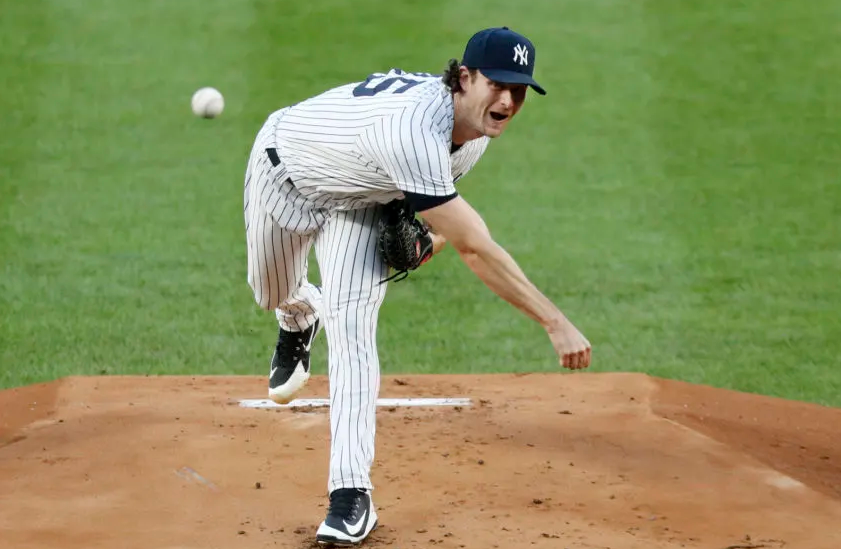

 Follow Us
Follow Us